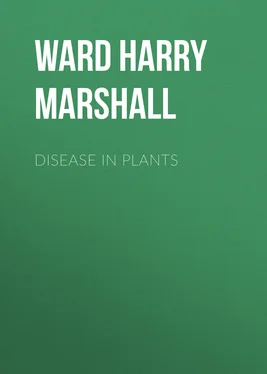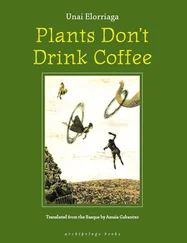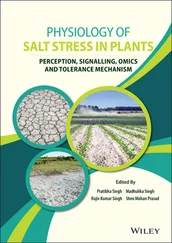Harry Ward - Disease in Plants
Здесь есть возможность читать онлайн «Harry Ward - Disease in Plants» — ознакомительный отрывок электронной книги совершенно бесплатно, а после прочтения отрывка купить полную версию. В некоторых случаях можно слушать аудио, скачать через торрент в формате fb2 и присутствует краткое содержание. Жанр: foreign_prose, Биология, Биология, foreign_edu, foreign_antique, на английском языке. Описание произведения, (предисловие) а так же отзывы посетителей доступны на портале библиотеки ЛибКат.
- Название:Disease in Plants
- Автор:
- Жанр:
- Год:неизвестен
- ISBN:нет данных
- Рейтинг книги:5 / 5. Голосов: 1
-
Избранное:Добавить в избранное
- Отзывы:
-
Ваша оценка:
- 100
- 1
- 2
- 3
- 4
- 5
Disease in Plants: краткое содержание, описание и аннотация
Предлагаем к чтению аннотацию, описание, краткое содержание или предисловие (зависит от того, что написал сам автор книги «Disease in Plants»). Если вы не нашли необходимую информацию о книге — напишите в комментариях, мы постараемся отыскать её.
Disease in Plants — читать онлайн ознакомительный отрывок
Ниже представлен текст книги, разбитый по страницам. Система сохранения места последней прочитанной страницы, позволяет с удобством читать онлайн бесплатно книгу «Disease in Plants», без необходимости каждый раз заново искать на чём Вы остановились. Поставьте закладку, и сможете в любой момент перейти на страницу, на которой закончили чтение.
Интервал:
Закладка:
There can be little doubt that Sachs' classical proof, by direct physiological observation and experiment, first brought forward the truth of organic synthesis in the plant in a concrete and convincing form.
But it did more than that. It laid the foundation of the modern physiology of plant-nutrition on ground already prepared by De Saussure and the earlier workers; for, in addition to emphasising the truth of organic synthesis—a truth which had been gradually impressing itself on the world for some years—Sachs' discovery showed clearly the real meaning of carbon-assimilation as a process for obtaining combustible food, which the plant then proceeds to make use of.
Many points were rapidly cleared up at once, or if not explained were at least put into a strong light for further enquiry, and plant-nutrition soon ceased to be the mysterious subject for all kinds of wild conjectures that it had hitherto been.
The meaning of thin leaves, with numerous stomata and finely ramified or divided vascular bundles, became more apparent, as also did the significance of the ascending transpiration current; the storage of starch-grains in tubers, medullary rays, roots, seeds, etc., obtained meanings not understood before; the spread of roots in the soil, and the gradually discovered properties of the finer rootlets and of the root-hairs, fitted naturally into their places; and, in short, a thousand facts, otherwise isolated, became collated into an intelligible system, full of suggestions for new work, such as has since gone on and is now being pursued with an activity and success never before realised in the history of science.
As time went on, while the general truth of Sachs' views was confirmed, a number of detailed discoveries were made which seemed to contradict them in certain points. It was found that not all leaves form starch, for some contain sugar or oil; but Holle and Godlewski proved experimentally that this oil may be replaced by starch if the conditions of assimilation are slightly modified. More recently Hébert discovered that the stalks and leaves of grasses contain a peculiar form of gum, which was formerly confounded with starch, a substance not abundant in them. Then came Schimper's discovery of starch-forming corpuscles, which, if supplied with sugar, are able to form starch-grains in the dark, as in tubers, etc., underground; and as subsequent researches have proved that the chlorophyll-corpuscles—which are morphologically the same as the starch-forming corpuscles and can be replaced by them—are also able to form starch-grains from sugar, as proved by the experiments of Boehm, Acton, Meyer, Laurent, Bokorny, Saposchnikoff, and others, it soon became evident that nothing essential needed altering in Sachs' view that starch is the first visible product of carbon-dioxide assimilation, only it became clearer that the starch-grains are built up by the protoplasm from glucose or some similar body, and represent so many packets of reserve materials put by for the present because not required for the immediate needs of the cell.
Boussingault showed, about thirty years ago, that assimilation soon stops in green leaves if cut off from the plant, not because the leaves die, but owing to some "maximum capacity" being attained. Sachs had shown that the starch passes down to other parts of the plant in solution as glucose.
Neither time nor space will permit me to go into the enormous field of research and results opened up by these and similar observations made between 1860-70. It must suffice to say that they led to the discovery and study of the diastatic and other enzymes in the leaves and other green parts of plants, and to a clearer understanding of what was already known of them in seeds, and this knowledge reacted at once on our insight into the processes of transport of reserve materials and constructive materials from one part of the plant to another, matters which will be referred to later on.
It remains to explain Boussingault's difficulty as regards the cessation of assimilation. Recent researches confirm the view that at least three causes are at work to bring about the inhibition of the carbon-assimilation: first, the chlorophyll-corpuscles become filled to excess with starch, which cannot get away because all the passages are full and the products are inhibiting the further action of the enzymes which should dissolve the solid granules; secondly, the leaf being detached from the plant explains why the soluble products cannot get away, for this makes a great difference in the rate of exhaustion of the leaf; and, thirdly, the same fact involves that the leaf can obtain no further supply of salts of potassium, etc., without which elements the processes in question cannot go on.
These and numerous other deeper insights into the process of assimilation, obviously strengthen the force of Sachs' discovery; though it by no means necessarily follows that starch-grains are always the resting form of the products of assimilation, and we now know that such is often not the case: we now have much deeper glimpses into the initial products of carbon-assimilation than Sachs had in 1860, but this enhances rather than detracts from the importance of his splendidly worked-out discovery. Put more generally, we may now say that the process of carbon-dioxide assimilation in green leaves under the influence of light is a process of synthesis—photo-synthesis—resulting in the building up of a carbohydrate such as sugar, inulin or starch from the elements carbon, hydrogen and oxygen.
But it must not be supposed that the importance of Sachs' discovery, and the rapid consequent extensions of our knowledge, did their work forthwith in disabusing men's minds of old and erroneous notions. To say nothing of numerous smaller misconceptions which still held their ground owing to the stupendous ignorance of plant-physiology which prevailed, we find incompetent teachers and text-books were still propagating ideas worthy of ancient times. The confusion between oxygen-respiration and the gas interchanges in carbon-assimilation was by no means eliminated even recently, though it can no longer withstand the deliberate onslaughts now made on it. That the roots take up food as such from the soil, and that that food is directly employed by the plant for its nutrition is even yet implied in daily conversation around us; and although matters have advanced so far that everyone now knows that the substances at the roots must be in solution, ere they can be received into the plant, it sometimes leads to astonishing replies, if we press the question very far as to how the absorption takes place, in an elementary examination of agricultural students. That manures are foods to the plant, that sap circulates, that transpiration is of use to keep the plant cool, and wood is a "porous body," etc., are only a few of the misconceptions still current, in a decade that has found publishers for a work advocating that roots are congealed sap, and that the leaves of plants absorb the moisture and dust of the air, and so provide the plant with food, and for a paper explaining the action of root-hairs as tubes with open pores at their tips. But the gravest misapprehensions current among us are due to the crude ideas as to what a plant really is: this, I take it, is owing to the difficulty of grasping what physiologists mean by organised structure, and leads to regarding the living being either as a mere aggregation of chemical compounds, built up by the ordinary play of chemical forces, as we know them, acting on dead matter, or, as in the days before organic chemistry, as a mysterious entity endowed with "vital force," and with properties not amenable to scientific investigation. The mistaken notions as to the powers of roots to "select" those substances which the plant requires, and to reject useless ones was merely an expression of this belief.
Читать дальшеИнтервал:
Закладка:
Похожие книги на «Disease in Plants»
Представляем Вашему вниманию похожие книги на «Disease in Plants» списком для выбора. Мы отобрали схожую по названию и смыслу литературу в надежде предоставить читателям больше вариантов отыскать новые, интересные, ещё непрочитанные произведения.
Обсуждение, отзывы о книге «Disease in Plants» и просто собственные мнения читателей. Оставьте ваши комментарии, напишите, что Вы думаете о произведении, его смысле или главных героях. Укажите что конкретно понравилось, а что нет, и почему Вы так считаете.












